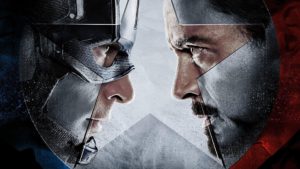
Marvel Studios / The Walt Disney Company
CAPTAIN AMERICA: CIVIL WAR
Starring Chris Evans (Steve Rogers / Captain America), Robert Downey Jr (Tony Stark / Iron Man), Scarlett Johansson (Natasha Romanoff / The Black Widow), Jeremy Renner (Clint Barton / Hawkeye), Chadwick Boseman (T’Challa / The Black Panther), Sebastian Stan (Bucky Barnes / The Winter Soldier), Don Cheadle (James Rhodes / War Machine), Elizabeth Olsen (Wanda Maximoff), Paul Bettany (The VISION), Anthony Mackie (Sam Wilson / The Falcon), Paul Rudd (Scott Lang / Ant-Man), Tom Holland (Peter Parker / Spider-Man), William Hurt (Thaddeus Ross), Emily VanCamp (Sharon Carter), and Daniel Bruhl (Helmut Zemo) with a special appearance by Stan Lee
Directed by Joe Russo and Anthony Russo
Produced by Kevin Feige
Written by Christopher Marcus and Stephen McFeely
Music By Henry Jackman
Distributed by Walt Disney Pictures
Run Time: 2 hours and 27 minutes
World Premier: April 12, 2016, in Hollywood, California
Opening Weekend Box Office: $179 million (North America)
Worldwide Box Office: $1.1 billion
Rotten Tomatoes Score: 90%
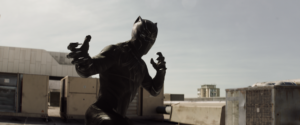
Marvel Studios / The Walt Disney Company
Memorable Captain America: Civil War Quotes
“I thought, [Captain America 3‘s] gotta be Civil War because we’re not gonna have a chance to do it again. It was a great event in the comics. And it seemed like we’d done enough of these movies now to earn it. And years before that, I used to think ‘Wouldn’t that be an amazing movie?’” – Kevin Feige
“We kept saying, ‘Look, we’ve already deconstructed [Steve Rogers]. The only thing we can do now is put him on a path toward rejecting the government in total. You threatened him personally in Winter Soldier, but what if you [next] threatened The Avengers as a group, and the ideology behind that group? That seemed to us a very logical progression.” – Joe Russo
“Plugging in characters like The Black Panther made sense because the narrative was asking for a third-party character who was as powerful and as present as Steve Rogers and Tony Stark who could carry a third storyline. And that’s not something you would give to a character that wasn’t interesting. You’d give it to somebody like T’Challa, like The Black Panther, who people will really be compelled by … I think Chadwick [Boseman] was very instrumental in building how this guy moves in the Black Panther suit, how he moves in everyday life. And all those components help to build a really compelling portrait.” – Nate Moore
“[The Black Panther] just kept coming up in vacations and dreams. And there were certain people that kept telling me that I should play the role. One particular guy had a Black Panther comic book put inside my trailer while I was shooting a movie in Australia. It was a comic book he had since he was a kid, and he was like, ‘I want you to have this. I feel like you’re gonna play this character.’ I guess he was prophetic.” – Chadwick Boseman
“I always wanted there to be very clear references to the Continent of Africa. Details in every way. Whether it be language, movement, fighting – even the suit, there are little hints of African masks or symbols of Africa inside it. We talked about all of those things, and they listened. That’s the thing about working with [Marvel Studios] is that they listen. They listen to what your concerns are and try to work with you.” – Chadwick Boseman
“Something that we at Marvel [Studios] have been dreaming about for a long time is bringing Spider-Man into the Marvel Cinematic Universe. When we were able to find a deal with Sony, it meant that Spider-Man got to join all of The Avengers [on-screen] in the same way that he has in publishing for years.” – Nate Moore
“The lucky thing is Kevin [Feige] and I come from the same place in terms of how we love Peter [Parker]. I’ve been working with Kevin on Spider-Man films since Sam Raimi’s. He would come to the meetings, get everyone coffee, and he never said a word for years. Which makes you love somebody because then, when they do open their mouth, you realize that they’ve been thinking all these big thoughts and are really smart, but never had to hear themselves talk.” – Amy Pascal
“Sony needs Spider-Man to be vital, and Spider-Man needed Marvel. We could fan our own egos as long as we wanted, but the truth is, every decision that you make in life is either [about] your ego or your ambition, and you better make sure your ambition wins.” – Amy Pascal
“[Civil War’s] the third film in the Captain America trilogy, but it also is a film that has a very important place among all the other films that we’ve made, in particular the other Avengers films. By this point, people know Steve Rogers very, very well. People know Tony Stark very, very well. And we felt it was time to see them [in conflict], because we know their personalities so well – we know how they work together, and we know that they have some issues with each other. They’re very, very different people. How would they react if they were faced with an issue that they just disagreed about?” – Kevin Feige
“Making this film was a completely surreal experience. Having grown up on comics, it’s a fantasy of everyone who reads them to see ‘Who’s stronger than who?’ and ‘What would happen if your favorite heroes fought each other?’ To be out there watching everyone in these costumes running at each other and just thinking ‘Wow, it’s the journey from being ten years old on the back porch of my buddy’s house reading Secret Wars to this!’ It’s amazing to see how much impact this mythology has on the people you grew up with, because they ascribe very specific feelings and ideas and emotions to those characters. They represent something very important to people.” – Joe Russo
“The story of Civil War is primarily about the conflict between Captain America and Iron Man, and between the sides that agree with each of them based on this mandate that is coming down from the governments of the world. At the same time, we are introducing another villain. There is somebody that is operating in the shadows, and while not responsible for the events that lead up to Civil War, he is fanning the flames and utilizing the conflict to his own advantage. That’s something that is going to have a very unique element not unlike the thriller elements of Captain America: The Winter Soldier that carries through into Civil War, and it does give a very different dynamic to the heroes, who at a certain point are realizing ‘We’re fighting each other, but there’s something else happening here; somebody is using the fact that we’re fighting each other to their advantage.’ He’s a very different kind of villain. We wanted to see what it would be like for a villain to take on The Avengers without throwing a punch.” – Kevin Feige discussing Helmut Zemo.
“I mean, Chris Evans does a bicep curl, with a helicopter. If you don’t love that, we can’t be friends.” – Tom Hiddleston expressing his enthusiasm for one of the most memorable scenes from Captain America: Civil War

Marvel Studios / The Walt Disney Company
Fun Captain America: Civil War Facts
On October 28, 2014, Marvel Studios President Kevin Feige hosted an impromptu event at the El Capitan Theater in Hollywood, California where he announced the full MCU Phase Three Slate forthcoming from Marvel Studios. The very first film announced was Captain America: Civil War after a title tease of Marvel Studios’ third Captain America film as Captain America: Serpent Society. With the Civil War reveal, Feige announced a May 6, 2016, release date and welcomed Chris Evans, Robert Downey Jr, and Chadwick Boseman to the stage with the announcement that Robert Downey Jr had signed a contract-extension with Marvel Studios to reprise his role as Tony Stark / Iron Man in the film and that Chadwick Boseman would be portraying Marvel Comics’ first Black Superhero: T’Challa / The Black Panther in the film! Feige would go on to announce eight more Marvel Studios films spanning the years 2016-2019: Doctor Strange (November 4, 2016), Guardians of the Galaxy Volume Two (May 5, 2017), Thor: Ragnarok (July 28, 2017), Black Panther (November 3, 2017), Avengers: Infinity War Part One (May 4, 2018), Captain Marvel (July 6, 2018), Inhumans (November 2, 2018), and Avengers: Infinity War Part Two (May 3, 2019).
Captain America: Civil War was a very loose adaptation of Marvel Comics’ 2006-2007 Civil War Event Series that saw Iron Man face-off against Captain America over the Superhero Registration Act; a regulation of superheroes by the Federal Government that required all costumed crime-fighters to register with the Government and reveal their true identity to the public. The event was a huge success for Marvel Entertainment and is among my most favorite Marvel Event Series’. The story ended with the surrender and consequent arrest of Captain America (Steve Rogers).
On February 9, 2015, Marvel Studios announced that a groundbreaking deal had been arranged with Sony Pictures that would bring Spider-Man into the Marvel Cinematic Universe. The deal would allow Spider-Man to appear in Captain America: Civil War and the two-part Avengers: Infinity War films while Marvel Studios would produce two Spider-Man solo films for Sony Pictures that would be set within the Marvel Cinematic Universe. The first Marvel Studios / Sony Pictures solo Spider-Man film would be titled Spider-Man: Homecoming and would take the July 28, 2017, release date previously slotted to Thor: Ragnarok. This provoked Kevin Feige to alter Marvel Studios’ previously announced Phase Three Film Slate with Thor: Ragnarok moving to November 2, 2017, Black Panther to July 6, 2018, and Captain Marvel to November 2, 2018. Inhumans was moved to after Avengers: Infinity War Part Two on July 12, 2019.
The film rights to Spider-Man and his supporting characters had been held by Sony Pictures for close to two decades. The first live-action Spider-Man film was produced by Sony in association with Marvel Studios in its previous incarnation under Avi Arad and released on May 3, 2002. That film starred Tobey Maguire and Kirsten Dunst and amassed $821 million worldwide (a Marvel movie record at that time). Spider-Man 2 starring Maguire and Dunst was released two-years later on June 30, 2004, to the tune of $789 million and being critically received as a better movie than the first one. Spider-Man 3 starring Maguire and Dunst was released three-years later on May 4, 2007, pulling in $894 million worldwide (a new Marvel movie record at that time, and one that was not broken until the release of The Avengers in 2012). On July 3, 2012, Sony Pictures rebooted their Spider-Man franchise with the release of The Amazing Spider-Man. That film generated $758 million at the worldwide box office and starred Andrew Garfield and Emma Stone. Two years later, The Amazing Spider-Man 2 was produced and released by Sony on May 2, 2014, to the tune of $709 million. That film also starred Andrew Garfield and Emma Stone. Sony Pictures came out of 2014 with a Spider-Man franchise that had amassed just shy of $4 billion at the worldwide box office, but The Amazing Spider-Man 2 was a critical failure for Sony in a year where films based on Marvel Characters were critical darlings with Marvel Studios’ Captain America: The Winter Soldier and Guardians of the Galaxy, and 20th Century Fox’s X-Men: Days of Future Past scoring big with critics and fans alike. Desperate, Sony Pictures’ Amy Pascal reached out to Marvel Studios President Kevin Feige for suggestions and Feige gave a simple solution: allow Marvel Studios to bring Spider-Man into the MCU where he belongs! Pascal scoffed at the notion initially, but cooler heads eventually prevailed, and a formal deal was made, which was announced as official on February 9, 2015. It was agreed upon that a new Spider-Man would be cast to portray the character within the Marvel Cinematic Universe, with both Sony and Marvel Studios both having a hand in the casting process and decision.
Captain America: Civil War commenced filming on April 27, 2015, in Fayetteville, Georgia. Shooting transpired at several locations across Georgia. In August, production moved to Germany, where filming wrapped on August 22, 2015.
On June 23, 2015, the casting of 19-year-old English actor Tom Holland as Peter Parker / Spider-Man was announced.
In Marvel Comics’ Civil War Event Series, Peter Parker / Spider-Man was a central part of the conflict between Iron Man and Captain America. Parker initially sided with Iron Man, and Tony Stark created the Iron Spider armor for Parker, who endorsed the Superhero Registration Act and publicly unmasked at a press conference that aired on television (much to the dismay of J. Jonah Jameson I might add, which was brilliant)! This ended up complicating Peter’s life in every single way that he ever feared such a thing would, and amidst feelings that Stark and his pro-registration heroes had crossed lines that should never be crossed, Spider-Man jumped over to Captain America’s side and emerged as not only an enemy of Iron Man, but a wanted felon. Due to the emotional impact that Peter Parker / Spider-Man had on the Civil War story in the comics, Kevin Feige saw Captain America: Civil War as an ideal place to formally introduce Spider-Man into the MCU, where he would align with Stark against Cap’s team of anti-registration heroes.
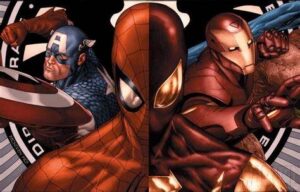
Marvel Entertainment / The Walt Disney Company
On August 31, 2015, The Walt Disney Company announced that henceforth, Marvel Studios would move out from under Marvel Entertainment and would fall directly under the jurisdiction of Walt Disney Pictures with Marvel Studios President Kevin Feige now answering directly to Walt Disney Studios Chairman Alan Horn instead of Marvel Entertainment CEO Ike Perlmutter. Reports emerged that revealed that Feige had nearly resigned as Marvel Studios President due to a rift between he and Perlmutter that had reached a boiling point over the course of the development of Captain America: Civil War, which was said to relate directly to Feige’s insistence that Marvel Entertainment approve of another contract extension for Robert Downey Jr so that he could co-headline the film, in addition to an adamant insistence from the Russo Brothers to not end Civil War with a reunion amongst the heroes as the Marvel Creative Committee wanted. Disney CEO and Chairman Bob Iger talked Feige down with the promise that changes would come imminently, and those changes formally manifested themselves at the end of the Summer of 2015, as Marvel Studios was removed from Marvel Entertainment and Kevin Feige no longer had to answer to Perlmutter or the Marvel Creative Committee.
Captain America: Civil War marked William Hurt’s return to the Marvel Cinematic Universe following an 8-year absence. Hurt portrayed General Thaddeus Ross in 2008’s The Incredible Hulk and his return made him the first main cast member from that film to reprise their role as their same character within the MCU.
In Captain America: Civil War, the speech given by Sharon Carter at her Aunt Peggy’s funeral is lifted from the pages of the comics; specifically, from Amazing Spider-Man # 537; a Civil War tie-in, written by J Michael Straczynski. In the comic, Cap says those words to Peter Parker / Spider-Man: “Compromise where you can. But where you can’t, don’t. Even if someone is telling you that something wrong is something right. Even if the whole world is telling you to move, it is your duty to plant yourself like a tree, look them in the eye, and say ‘No, you move.’”
In Captain America: Civil War, Alfre Woodard portrays Miriam Sharpe, a mother who lost her son during the Battle of Sokovia and that inspires Tony Stark to champion The Accords. Woodard also portrays Mariah Dillard-Stokes in the original Marvel Television’s Luke Cage series. This rare case of double-casting used to seemingly serve as evidence that Marvel Television’s Defenders Saga was not canon to the MCU, but that has changed now that Marvel Head of Streaming, Television, and Animation: Brad Winderbaum has come out and confirmed that all of the now former Netflix shows that comprised The Defenders Saga are MCU canon and that the events seen in those shows take place upon the MCU (Sacred) Timeline and within the MCU 616-Universe. When including these now former Netflix shows that now reside on Disney+, in the chronological MCU Timeline, Captain America: Civil War should be viewed after The Defenders miniseries and before the 2021 Marvel Studios film Black Widow.
Captain America: Civil War marked Stan Lee’s 13th MCU cameo appearance for Marvel Studios. Stan portrayed a FedEX delivery driver in this film, sharing his scene with Robert Downey Jr and Don Cheadle.
The first trailer for Captain America: Civil War premiered on November 25, 2015, on ABC’s Jimmy Kimmel Live! The trailer was viewed 61 million times during its first 24-hours of release. A second trailer aired during the NFL’s Super Bowl 50 on February 7, 2016, which saw Peyton Manning and the Denver Broncos down Cam Newton and the Carolina Panthers by a final score of 24-10. Another Civil War trailer was released in March that offered fans a first look at the MCU’s Spider-Man.
Marvel Studios had several promotional partners for Captain America: Civil War including Lego, Funko, Hasbro, Kellogg’s, Hallmark, Coca-Cola, Google, Samsung, and Pizza Hut. 2016 also marked a celebratory milestone for the Captain America character as it was Cap’s 75th Anniversary.
On July 31, 2016, at the Teen Choice Awards, Captain America: Civil War won the Award for Choice Movie: Sci-Fi / Fantasy and Chris Evans won the Award for Choice Movie Actor: Sci-Fi / Fantasy for his portrayal of Steve Rogers / Captain America in Captain America: Civil War.
Captain America: Civil War was released on Blu-ray, DVD, and Blu-ray 3D on September 13, 2016, in the United States. Today, the film can be streamed on Disney+.
Captain America: Civil War became Marvel Studios’ fourth billion-dollar film following The Avengers, Iron Man 3, and Avengers: Age of Ultron. It was also the highest-grossing motion picture of 2016; the second time Marvel Studios had accomplished that feat, with the first being 2012’s The Avengers.
On January 18, 2017, at the People’s Choice Awards, Robert Downey Jr won the Award for Favorite Action Movie Star for his role as Tony Stark / Iron Man in Captain America: Civil War. On June 28, 2017, at the Saturn Awards, Tom Holland won the Award for Best Performance by a Young Actor for his portrayal of Peter Parker / Spider-Man in Captain America: Civil War.

Marvel Studios / The Walt Disney Company
My Captain America: Civil War Review
Captain America: Civil War was a masterpiece of a film that served at the time as a sort of culmination of the Marvel Cinematic Universe, showcasing everything that made the concept of a Shared Universe special! There were returning characters, surprises, and the introduction of several new characters, a couple of which that would have long-term impact on the MCU. Captain America: Civil War was also the last film made by Marvel Studios in conjunction with Marvel Entertainment and the first film in which Marvel Studios incorporated the character that inspired their revolutionary deal with Sony Pictures.
So much effort and so much careful attention was paid to making this story work, and all involved should be commended for the risks, the vision, and the execution that were required to pull this motion picture off.
From a storytelling standpoint, this was an excellently written film. It made perfect sense for the governments of the world to want to regulate The Avengers following the Fall of S.H.I.E.L.D., and not only because they had no overseeing government body to answer to, but because their avenging had resulted in monumental casualties and destruction. Yes, they’d saved countless lives with their heroics, but underneath all the hype, there were victims and mourners who were overwhelmed by grief. People like Miriam Sharpe and Helmut Zemo. Having General Ross show footage of the wreckage from battles in New York, Washington, and Sokovia perfectly illustrated this point, and going one step further and having the confrontation in Lagos, Nigeria be the tragedy that inspired world leaders to pass the Accords into law was perfect, with the Nation of Wakanda championing them. All of this made sense, and all of this set the stage for the conflict that would tear The Avengers apart and ultimately doom half of all life within the Universe.

Marvel Studios / The Walt Disney Company
Captain America: Civil War is a heavy film. It juggles a lot of complex themes while trying to force viewers to analyze their own ideas, beliefs, and values and to choose a side while their favorite characters wage war. It’s a film rich in drama, but also in action, and the movie wastes no time getting things started as the film opens in Lagos where we catch up with The New Avengers and their battle with Brock Rumlow, who has now become renowned as the terrorist Crossbones. This is a high-octane fight that was spectacularly filmed. Crossbones is on a mission to acquire a dangerous virus from the CDC and Captain America, The Falcon, The Black Widow, and Wanda Maximoff are there to stop him. This sequence allowed us to get more of that Captain America being awesome stuff that The Russo Brothers gave us in The Winter Soldier, and also showed how far Wanda had come since Age of Ultron in terms of using her unique powers. Sadly, we soon realize that Wanda hasn’t come quite far enough though, as when Crossbones attempts to detonate a suicide bomb that is intended to take Captain America with him, Wanda contains the blast (saving Steve and no doubt torturing Rumlow) before directing Crossbones into the air, at which point she loses control, and Rumlow’s blast detonates in a nearby building, taking the lives of several citizens, including dignitaries from Wakanda. This was a tragedy the likes of which The Avengers simply could not afford following the incidents in Johannesburg and Sokovia, which were both caused by The Avengers, even if indirectly. The Hulk rampaged through Johannesburg and engaged Iron Man in a huge fight. Though he was under the influence of Wanda Maximoff at the time, The Hulk was still the one who physically ravaged the city, and even those who perhaps did understand that The Hulk was under some sort of spell, the person who cast that spell upon The Hulk was now working with The Avengers, and it was she who intentionally or not, caused the tragedy in Lagos. As for Tony Stark, he was right in the middle of the destruction that The Hulk unleashed, and on top of all of that, it was he (with Banner) that created ULTRON. So no, The Avengers were not exactly beloved heroes in the eyes of the public at this point, especially Iron Man, The Hulk, and Wanda Maximoff, and Natasha Romanoff wasn’t too high on people’s lists either, given that so many details of her past as a Russian spy had been leaked during the S.H.I.E.L.D. data dump at the end of The Winter Soldier.
So came the Sokovia Accords and a major change in the status quo of the Marvel Cinematic Universe as The Avengers began to voice their respective endorsements and concerns. For Steve Rogers, the Accords were a no-go. Even though he’d been a man that made following orders and fighting for his Country a way of life, he’d awoken to a dramatically different world when he was revived by S.H.I.E.L.D. He tried to carry on with his prior convictions and ambitions. He didn’t hesitate to accept Fury’s mission, nor did he have any reservations of note when it came to working alongside other exceptional people for the common good. Even after the Battle of New York, Steve continued working for Fury as an Agent of S.H.I.E.L.D., but then Hydra’s role within S.H.I.E.L.D. was exposed and Captain America learned that nothing was as it had seemed. This revelation shattered Steve emotionally, and left his blind patriotism fractured. Following orders wasn’t so simple now, nor was trusting the government; any government, for governments are run by people and people have their own agendas. In Civil War, Steve no longer trusts people like he once did. He is leery and even a bit paranoid at this point, with only a small circle of friends and teammates that he knows he can trust: Natasha Romanoff, Sam Wilson, Wanda Maximoff (given she saved his life in Lagos), and of course … Bucky Barnes; his best friend since childhood. Each member of Steve’s inner circle are people that he can relate to. He was turned into Captain America by his Country to serve his Country. Wanda Maximoff (through the Mind Stone) received her enhancements under similar conditions. Natasha Romanoff (through brainwashing) was also created to be a Black Widow by her government. As for Sam, he was – like Steve – a soldier; and a soldier who lost his own best friend while serving his Country. Steve had gone from following orders to questioning everything (though the solo WWII mission in Italy and his repeated efforts to enlist did show hints of a rebellious streak) and this was a new angle for him.

Marvel Studios / The Walt Disney Company
Then, there’s Tony Stark! The rebel. The cynic. The hero yes, but Stark was adamantly against the idea of joining Nick Fury’s Avenger Initiative from the start. Tony was just fine being Iron Man all on his own, and he could not have cared less whether even his own government endorsed him. Stark was dead set against sharing his Iron Man technologies with the military and he delighted in basking in the glory of Iron Man’s accomplishments. This was the guy that said, “I am Iron Man”, because he wanted to be a superhero. He wasn’t concerned with secret identities or covert missions; he wanted to be a hero, and he wanted to be seen being a hero. He didn’t need the United States or S.H.I.E.L.D. meddling in his affairs or sharing in his spotlight. The events of Iron Man 2 and Tony’s struggle with his own mortality warmed Tony up to the idea of maybe working with others who shared his goal to make the world a better and safer place, and this change of attitude allowed him to unite with The Avengers when the time came to defend the Earth, and Tony even made the sacrifice play that Captain America had said he would never make to save New York. That moment changed Tony too though. He came out of his big moment with a fractured psyche and a shattered ego. Iron Man or not, Tony Stark no longer felt big. For the first time in his life, Tony Stark felt small. He was traumatized and afraid, and because of this, he continued working with S.H.I.E.L.D. even after the Battle of New York, sharing his technologies to improve S.H.I.E.L.D. weaponry. He was fine with Pepper Potts running his company and with Rhodey working in one of his suits for the military. Stark didn’t want humanity to find itself on the defensive again; he wanted to go on the offensive and that’s where the idea for ULTRON came from: Tony’s vision for a suit of armor around the world. ULTRON backfired of course, in ways Tony never could have imagined, for he had no idea what the Cosmic Scepter really was, nor what it contained. He simply saw a means to an end, and that directly resulted in the tragedies that befell Johannesburg and Sokovia. ULTRON (as Tony admits in this film) was his fault and he knows that for everything that went right in Sokovia, it could have easily gone the other way, and this uncomfortable feeling of guilt and responsibility reaches a boiling point when Tony is confronted by Miriam Sharpe. He now sees things from the ground-level. And it’s torture. Tony wants to make right by the people whose lives he has had a part in negatively affecting. Tony needs to somehow make right by those people, and he sees the Accords as the way to do that. Embrace regulation. Be a team player. Have a plan and have the means to execute that plan. And, if things go afoul in the future, let the blame fall on someone else for a change. This is a new angle for Tony.
Before the debate over the Accords goes any further, Steve Rogers receives news that his beloved Peggy Carter has passed away; succumbing to the cruel and terrible disease that afflicted her. Peggy’s funeral is both sad and moving, and it reunites Steve with Peggy’s niece Sharon for the first time since the Hydra Uprising. I loved Sharon’s speech (actually Peggy’s words), and I loved that both Sam and Natasha went to the funeral to support their friend during his time of loss. Things take a quick turn from there however, as we see Natasha venture out to sign the Accords in a public show of support for the legislation on behalf of The Avengers. We are introduced to both Wakandan King’ T’Chaka and his son Prince T’Challa during this sequence, which ends in terror amidst a bomb blast that takes the lives of several people, including King T’Chaka. This instantly sets T’Challa on a quest for vengeance; a quest that is complicated by reports that The Winter Soldier was the entity behind the blast.
Bucky Barnes is labeled public enemy number one and a massive manhunt for the elusive Winter Soldier ensues. Steve knows that Bucky will be shot on-sight, so his two-year search for his friend becomes all the more critical. Sharon (now a CIA Agent) points Steve in the right direction and Steve tracks Bucky down just before forces close in to take Bucky out. From there, Captain America teams-up with The Winter Soldier against the Task Force sent to terminate him. Then, T’Challa joins the fight, suited up as The Black Panther; Protector of Wakanda, physically enhanced by the otherworldly Heart-Shaped Herb, sacred to his Nation. This extremely exciting sequence ends with the arrival of James Rhodes / War Machine (having already signed the Accords) and the arrests of Captain America, The Falcon, and The Winter Soldier.
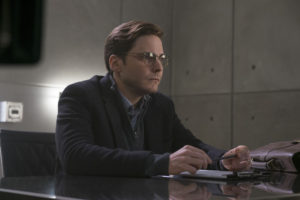
Marvel Studios / The Walt Disney Company
Back at Task Force Headquarters, Tony Stark (who has also signed the Accords) urges Steve to sign them, and despite the tension and contempt that Tony allows Steve to see, Stark almost succeeds in convincing Cap to sign the Accords, but that is until Steve discovers that Tony is keeping Wanda under house arrest that is overseen by The VISION (who has also signed the Accords), and that Wanda’s fate is ambiguous, as she has been classified as a living Weapon of Mass Destruction. Steve is repulsed by this news and chastises Tony for going along with all of this. Steve does not sign, and then, The Winter Soldier is broken out of custody by the man who framed Bucky for the bombing that took King T’Chaka’s life: Helmut Zemo.
Zemo activates Bucky’s Winter Soldier programming and Barnes makes a violent escape, crossing paths with The Falcon, Iron Man, Sharon Carter, The Black Widow, and Prince T’Challa along the way. As he makes his escape, Captain America gives chase, and we get an awesome helicopter sequence which leads to Cap taking Bucky into his own custody where Barnes finally admits that he remembers Steve and tells Captain America and The Falcon that there are other Winter Soldiers.
This serves to unite Steve, Bucky, and Sam on a mission to get to Siberia and prevent Zemo from unleashing the other Winter Soldiers upon the world. Knowing that they will need backup and knowing that Stark and Ross will try to prevent them from leaving the Country, Cap and Sam recruit Hawkeye, Wanda Maximoff, and Ant-Man.
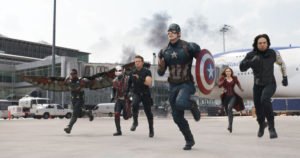
Marvel Studios / The Walt Disney Company
Hawkeye is tasked with breaking Wanda out from The VISION’s custody, while Sam reaches out to his one-time rival Scott Lang. Everyone answers the call, and Steve has his team!
Tony, under orders from Thaddeus Ross to arrest and detain Captain America, The Winter Soldier, and The Falcon puts together a team of his own comprised of himself, Rhodey, The VISION, Prince T’Challa, and surprisingly Natasha Romanoff. Stark also recruits a young man named Peter Parker, whose recent exploits he’d been following. Exploits as the web-swinging costumed hero known as Spider-Man!
It really was amazing seeing Spider-Man in the Marvel Cinematic Universe sharing the screen with Iron Man, Captain America, The Black Widow, Hawkeye, The Winter Soldier, The Black Panther, War Machine, The Falcon, The VISION, Wanda Maximoff, and Ant-Man! Tom Holland was perfectly cast by Marvel Studios and Sony Pictures, and he was an absolute scene stealer during the Airport Fight, which was for me, the single greatest scene in comic book movie history at the time of its release in 2016! It had things I’d always wanted to see as well as a few things I never imagined that I would see! Ant-Man becoming Giant-Man was mind-blowing, and Paul Rudd was hilarious throughout the fight (gotta throw a shout-out to his Captain America obsession; so good)! Spider-Man was also very funny with his constant quipping and compliments for the heroes that he’s fighting, and his yelling and screaming. He was a high school student that was star-struck and overwhelmed by the fact that he was fighting alongside and against these larger-than-life people that he’d adored since childhood and aspired to be like once he received enhancements of his own through the bite of an unnamed spider. Other highlights included Spider-Man vs Captain America, Hawkeye shooting a miniature Ant-Man on the edge of his arrow (a scene ripped right out of the comics), Natasha’s turn to assist Steve and Bucky in fleeing, and The VISION inadvertently shooting Rhodey out of the sky with a Mind Stone blast that took out Rhodes’ Arc Reactor. Rhodey’s paralysis was shocking, as was the fact that he survived it, and Tony’s aggravated reaction against Sam was priceless.
Having escaped, Steve and Bucky make their way to Siberia while The Falcon, Scott Lang, and Clint Barton are all arrested and imprisoned within the super-prison known as the Raft. Tony – who really flirted with outright villainy here for a bit – soon discovered that Zemo was the one behind the Accords bombing after all and that he had not been as right as he thought he’d been. Stark therefore suits up as Iron Man and ventures to Siberia to assist Steve and Bucky in their battle against the other Winter Soldiers. T’Challa covertly follows Tony there.
In Siberia, Zemo’s master plan is revealed as Tony, Steve, and Bucky discover the other Winter Soldiers to be dead (killed by Zemo). Zemo then subjects the trio to video footage taken from a surveillance camera on December 16, 1991, … footage that reveals that Bucky Barnes / The Winter Soldier caused the car crash that supposedly took the lives of Tony Stark’s parents Howard and Maria, and that it was Bucky himself that coldly murdered Howard and Maria on his mission from Hydra to acquire serum samples that would be used to create the other Winter Soldiers.
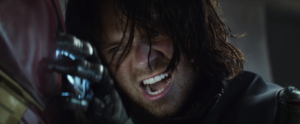
Marvel Studios / The Walt Disney Company
I had seen this coming from a mile away, but it didn’t hinder the film at all. Instead, it strengthened it, because it made sense. It added huge stakes, and it moved Steve and Tony’s relationship / friendship beyond pride and jealousy. There were two bitter truths that Tony had to cope with here. One, The Winter Soldier murdered his parents. And two, Captain America knew it. Robert Downey Jr, Chris Evans, and Sebastian Stan were phenomenal during this sequence. You can see the fear on Steve Rogers’ face, you can see the sad frustration in Bucky’s eyes, and you can see the utter disdain on Tony Stark’s face. The ensuing fight wasn’t about cheering or being blown away by spectacle. It was emotional and tragic and extremely intense. Watching Bucky try to rip out Tony’s Arc Reactor and watching Tony blast off The Winter Soldier’s mechanical arm and then watching Steve stop just short of killing Tony with the shield that Howard Stark made for Captain America … it was almost too much!
My heart broke for all three characters, and it was at this moment in the film that I realized no one was right and no one was wrong. This wasn’t about heroes and villains. This was about life and death. About trust and friendship. This was about honor and morality. I also realized as I watched Cap throw down the shield, that the narrative of the MCU had fundamentally changed. This would be a hard thing for Iron Man and Captain America to come back from and consequently, Earth had lost its Mightiest Heroes.
Wrapping things up, Zemo (who as it turned out, had lost his wife and child during the Battle of Sokovia) was prevented from committing suicide by Price T’Challa, who then offered refuge in Wakanda for The Winter Soldier, with a promise to Captain America to protect Bucky and work on devising a way to deprogram Barnes and free his mind. Steve meanwhile wrote Tony a letter in an effort to apologize for keeping the truth about his parents’ deaths from Stark. Bucky was placed back under cryogenic stasis in Wakanda, and Steve (with help from Natasha as we would later learn) broke his friends Sam and Wanda out of prison. Meanwhile, Natasha returned to Russia as a fugitive and Scott Lang and Clint Barton both made deals with Ross that required them to serve a sentence under house arrest and refrain from superhero activities. Prince T’Challa would embark upon his destiny to be King of Wakanda, and young Peter Parker would continue serving his community as a Friendly Neighborhood Spider-Man in New York, fueled by his ambition to someday become an Avenger.
Zemo was locked up in custody. But Zemo had won.
I think Civil War was for me, the moment that I no longer felt that anyone else should ever portray Tony Stark or Steve Rogers on film. I still feel that way to this day. Robert Downey Jr is the living embodiment of the Tony Stark character and Chris Evans is the living embodiment of Steve Rogers. I know that deciding against recasting is a difficult move for a Universe based on comic book characters, but RDJ and Evans defined Stark and Rogers for a generation. They breathed life into those characters, and long past their lifetimes, will be associated with those characters as fans will see their faces in art and hear their voices in comic books that they read. I thought Civil War was the best performance by either actor in the MCU and I came out of the theater with this film replacing Avengers: Age of Ultron as my favorite MCU film.

Marvel Studios / The Walt Disney Company
Highlights of Captain America: Civil War:
Chris Evans is Steve Rogers / Captain America
Robert Downey Jr is Tony Stark / Iron Man
The Airport Fight
Tension Between Chris Evans and Robert Downey Jr
Chemistry Between Chris Evans and Sebastian Stan
Tom Holland is Peter Parker / Spider-Man
Chadwick Boseman is T’Challa / The Black Panther
Elizabeth Olsen is Wanda Maximoff
Scarlett Johansson as Natasha Romanoff / The Black Widow
Double Agent Black Widow
Paul Rudd as Scott Lang / Ant-Man
Giant-Man!
Funeral for Peggy Carter
The Winter Soldier Killed The Stark’s Plot Point
Opening New Avengers vs Crossbones Sequence
Spirit of the Comics Perfectly Captured

Marvel Studios / The Walt Disney Company
Continue Following Tony Stark’s MCU journey in Spider-Man: Homecoming (2017), Avengers: Infinity War (2018), and Avengers: Endgame (2019).
Continue Following Steve Rogers’ MCU journey in Spider-Man: Homecoming (2017), Avengers: Infinity War (2018), Captain Marvel (2019), and Avengers: Endgame (2019).
Continue following Natasha Romanoff’s MCU journey in Avengers: Infinity War (2018), Captain Marvel (2019), Avengers: Endgame (2019), and Black Widow (2021).
Continue following Clint Barton’s MCU journey in Avengers: Endgame (2019), Black Widow (2021), and Hawkeye (2021).
Continue following the MCU journey of Wanda Maximoff in Avengers: Infinity War (2018), Avengers: Endgame (2019), WandaVision (2021), and Doctor Strange in the Multiverse of Madness (2022).
Continue following the MCU journey of The VISION in Avengers; Infinity War (2018) and WandaVision (2021).
Continue following the MCU journey of T’Challa in Black Panther (2018), Avengers: Infinity War (2018), and Avengers: Endgame (2019).
Continue following the MCU journey of Bucky Barnes in Black Panther (2018), Avengers: Infinity War (2018), Avengers: Endgame (2019), The Falcon and The Winter Soldier (2021), Captain America: Brave New World (2025), and Thunderbolts* (2025).
Continue following the MCU journey of Peter Parker in Spider-Man: Homecoming (2017), Avengers: Infinity War (2018), Avengers: Endgame (2019), Peter’s To-Do List Short Film (2019), Spider-Man: Far From Home (2019), and Spider-Man: No Way Home (2021).
Continue following the MCU journey of Scott Lang in Avengers: Infinity War (2018), Ant-Man and The Wasp (2018), Avengers: Endgame (2019), and Ant-Man and The Wasp: Quantumania (2023).
Continue following the MCU journey of James Rhodes in Avengers: Infinity War (208), Captain Marvel (2019), Avengers: Endgame (2019), The Falcon and The Winter Soldier (2021), and Secret Invasion (2023).
Continue following the MCU journey of Sam Wilson in Avengers: Infinity War (2018), Avengers: Endgame (2019), The Falcon and The Winter Soldier (2021), and Captain America: Brave New World (2025).
Continue following the MCU journey of Thaddeus Ross in Avengers: Infinity War (2018), Avengers: Endgame (2019), Black Widow (2021), and Captain America: Brave New World (2025).
Continue following the MCU journey of Sharon Carter in The Falcon and The Winter Soldier (2021).
Continue following the MCU journey of Helmut Zemo in The Falcon and The Winter Soldier (2021).

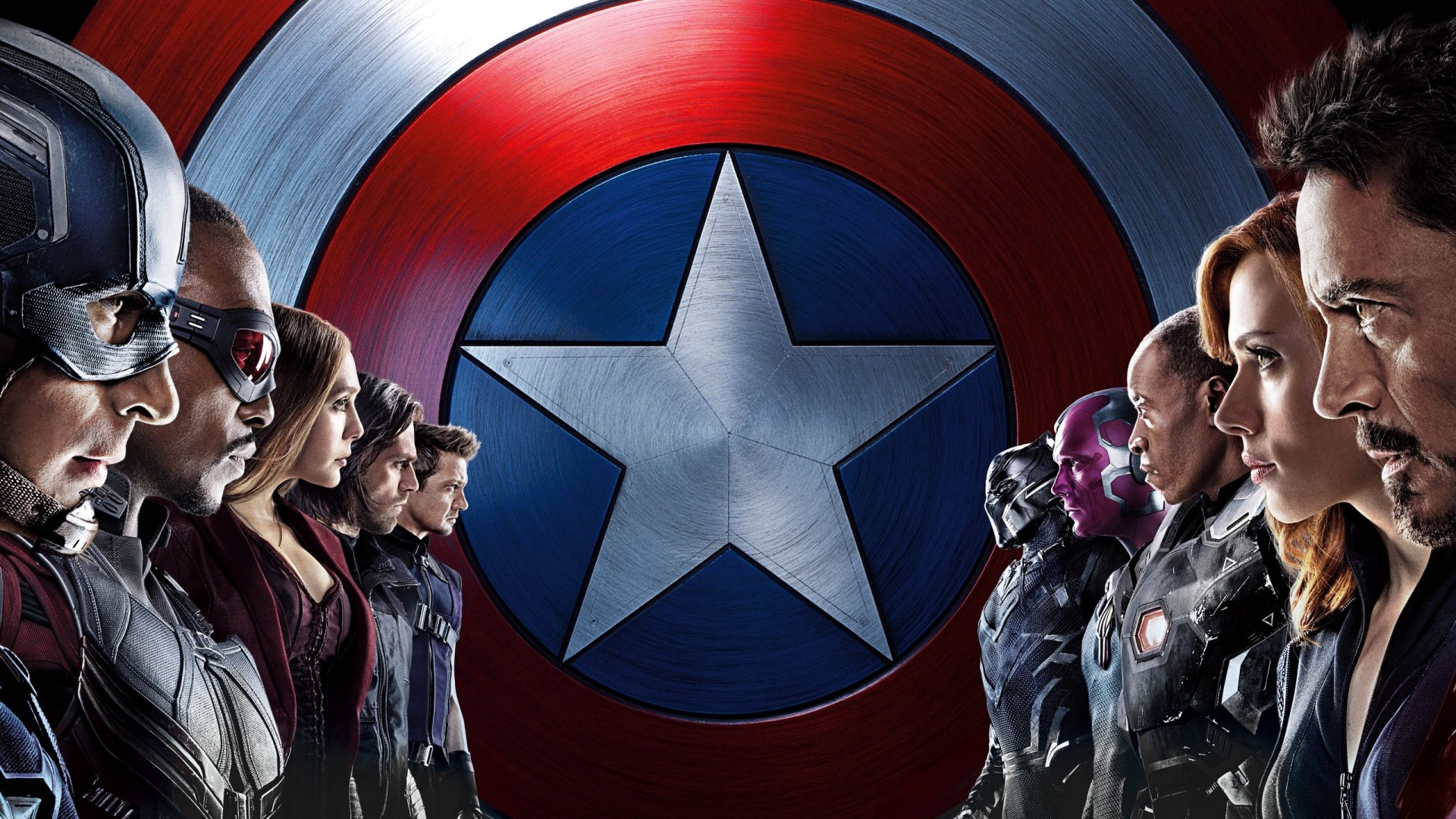
Leave a Reply